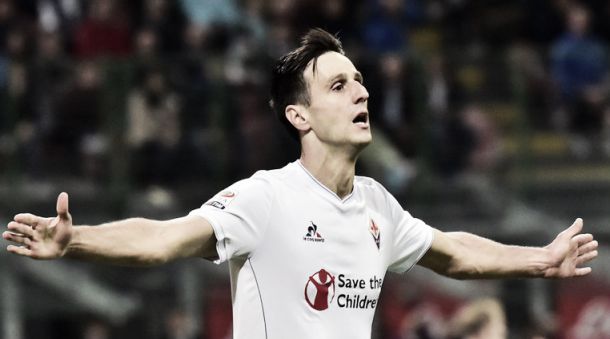Few would have forecasted the impact of Nikola Kalinic upon arrival in Florence. Coaxed from Dnipro to help alleviate the goalscoring burden on the injury-ravaged Giuseppe Rossi after the departure of Mario Gomez, the Croatian has catalysed Fiorentina's remarkable start to the campaign and helped propel his new employers to the summit of the Serie A table for the first time since 1999.
Snap judgements were rife upon the forward's arrival. Kalinic was, on paper at least, an ageing forward, encumbered by his lanky frame and was ostensibly purchased on the back of his creditable goal-scoring return for Dnipro as they flouted expectations and reached the final of the UEFA Europa League. He was, as many had observed, the antithesis of Fiorentina's brand of football: burly and sluggish; the sporting manifestation of a camel galumphing through the sun-scorched desert.
Except his arrival, coinciding with the appointment of head coach, Paulo Sousa, marked a turn in approach. The possession-orientated blueprint was jettisoned after Vincenzo Montella's dismissal and in its place came a more direct, physical brand of football. The principles remained intact - a desire to dictate possession - but instead, Sousa wanted to install a system that, in his words, "is both knowing and aggressive – both with and without the ball".
More commonly renowned for his ill-fated spell with Blackburn Rovers at the turn of the decade, Kalinic has reversed his fortunes in Viola and has the Fiorentina fraternity beginning to dream about a first Serie A crown since the year of the moon landing.
Unenviable circumstances
Granted the fabled No. 9 jersey, once donned by legendary goalgetter, Gabriel Batistuta, Kalinic arrived into a cauldron of pressure in northern Tuscany.
The situation certainly wasn't aided by the impromptu exit of head coach, Vincenzo Montella. The Italian had presided over four years of sustainable progress at the club, steering them to the precipice of Champions League football, and was seemingly discarded through a desire to smash the proverbial glass ceiling.
Moreover, Mohamed Salah, who provided the necessary shot in the arm after his arrival from Chelsea in January, had rebuffed the club's offer to extend his loan deal by an extra year, instead opting to team up with Rudi Garcia in the capital. Further, Stefan Savic, whose influence grew profoundly under Montella last term, sought pastures new in Madrid, while goalkeeper, Neto, who accrued over 70 appearances between the Viola sticks in four years, joined bitter rivals Juventus on a Bosman.
But for the myriad problems facing the club, a convincing pre-season was not one of them. Their victories over FC Barcelona and Chelsea were quickly dismissed as trivial; the real yardstick, it was assumed, was the campaign opener against AC Milan, a club bristling with confidence after lavishing over €80million in new recruits over the summer months.
Added verticality
Sousa had demanded that his side play with intent, that the habitual lulls in possession were offset by direct transitions into the Croat, flanked by the burgeoning duo of Fernando Bernardeschi and Josip Ilicic.
The signs of a pattern shift were manifold when Milan defender, Rodrigo Ely, was given his marching orders midway through the first-half after hauling the forward to the floor. The Croat had played a lovely give-and-go with Borja Valero before being tugged back by the youngster en route to goal. Damningly, the 21-year-old had committed a similar offence on Kalinic earlier in the half - which warranted a yellow in process.
Marcos Alonso dispatched the subsequent free-kick to compound the visitors misery, but the Croat's authority was already manifest. He had been liberated by Ilicic through the heart of the Milan rearguard during the opening exchanges, only for Diego Lopez to thwart his attempt.
Another hallmark of Sousa's tenure, moreover, has been the combination play. Movements seem instinctive, passes seem crisp and, despite fluctuating between formations, there appears a telepathic understanding between players.
Kalinic's rapport with left-back, Marcos Alonso, formerly of Sunderland, has been a sight to behold. The pair have dovetailed beautifully to create openings, with the Croat's predatory movement inside the penalty box the perfect complement to the Spaniard's expertly driven crosses across the 18-yard box.
The duo combined to engender Fiorentina's second against Bologna last month, with Alonso supplying a delicious cross into the Croat who slid his effort past Antonio Mirante in the visitors goal. Four days later, they linked to double La Viola's advantage at the San Siro. Yet again Alonso burst down the left and, yet again, Kalinic ghosted into the penalty area to slide the ball home.
A newfound dimension
Even despite his goal-scoring exploits for Dnipro in Europe's second-tier competition last time out, Kalinic arrived in Florence a relatively obscure entity.
Reductive assessments were aplenty when his signing was confirmed and, at 6ft2 with a shoddy goalscoring record, the Croat was viewed as an alternative. Sousa had spoke of his craving to transform Fiorentina into a more dynamic outfit and his capture, where he would compete alongside the diminutive Rossi and the robust Khouma Babacar, would equip the manager with a strikingly eclectic mix of forwards.
Kalinic, however, has flouted pre-season assumptions. Not only has he became conducive to Sousa's style of play but, remarkably, he offers the side a genuine potent threat behind opposition rearguards.
Sides have failed to learn from Milan's precedent, where Sinisa Mihajlovic deployed a high-line and was fortunate not to head into the dressing room at half-time three-goals behind, and Fiorentina have ruefully exploited that.
Roberto Mancini was naïve in his approach, perhaps bouyed by his side's flawless start to the campaign, and attempted to press high and suffocate the Fiorentina midfield three. The visitors, though, were shrewd and were quick in shifting possession into the final-third - as Sousa preaches.
Kalinic had already netted twice and was responsible for Miranda's dismissal by the interval. Inter may have grabbed a consolation through Mauro Icardi, but even the Argentine was hapless in preventing the visitors from adding a fourth and, more importantly, Kalinic grabbing his hat-trick.
Parallels were drawn between Inter's ignominious 4-1 home defeat to Cagliari in 2014 and the demolition concocted by Kalinic and co. More ignominious, however, was the humble pie being consumed by those who doubted Kalinic's goalscoring ability.










































